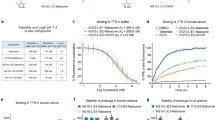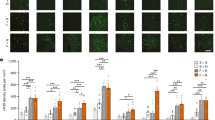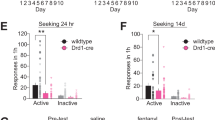Abstract
Methocinnamox (MCAM), a mu opioid receptor antagonist with a long duration of action, attenuates heroin self-administration in rhesus monkeys, suggesting it could be an effective treatment for opioid use disorder (OUD). This study examined effects of acute and repeated MCAM administration on self-administration of the high-efficacy mu opioid receptor agonist fentanyl and characterized MCAM pharmacokinetics. Four rhesus monkeys self-administered i.v. infusions of fentanyl (0.00032 mg/kg/infusion) or cocaine (0.032 mg/kg/infusion). MCAM (0.1–0.32 mg/kg) or the opioid receptor antagonist naltrexone (0.001–0.032 mg/kg) was injected prior to test sessions to evaluate acute effects. On a separate occasion, 0.32 mg/kg MCAM was injected every 12 days for 5 total injections to evaluate the effectiveness of repeated treatment. Following acute injection, MCAM and naltrexone decreased fentanyl self-administration on the day of treatment, with attenuation lasting for up to 2 weeks after the larger MCAM dose and <1 day after naltrexone. Repeated MCAM administration decreased fentanyl self-administration for more than 2 months without altering cocaine self-administration. MCAM plasma concentrations peaked 15–45 min after injection, with a half-life ranging from 13.7 to 199.8 min, and decreased markedly 1 day after injection. MCAM selectively reduced opioid self-administration and remained effective with repeated administration. Moreover, MCAM was effective at times when plasma levels were very low, suggesting that pharmacodynamic (i.e., pseudoirreversible binding to mu opioid receptors) and not pharmacokinetic factors play a significant role in its long-lasting effects. Taken together with previous studies, these data indicate that MCAM could be a safe, effective, and long-acting treatment for OUD.
Similar content being viewed by others
Log in or create a free account to read this content
Gain free access to this article, as well as selected content from this journal and more on nature.com
or
References
Hedegaard H, Bastian BA, Trinidad JP, Spencer M, Warner M. Drugs most frequently involved in drug overdose deaths: United States, 2011–2016. Natl Vital Stat Rep. 2018;67:1–14. https://www.cdc.gov/nchs/data/nvsr/nvsr67/nvsr67_09-508.pdf Accessed 30 December 2019.
Jones CM, Paulozzi LJ, Mack KA. Centers for Disease Control and Prevention (CDC) Alcohol involvement in opioid pain reliever and benzodiazepine drug abuse–related emergency department visits and drug-related deaths—United States, 2010. MMWR Morb Mortal Wkly Rep. 2014;63:881–5. https://www.ncbi.nlm.nih.gov/pmc/articles/PMC4584609/ Accessed 30 December 2019.
Jones CM, McAninch JK. Emergency department visits and overdose deaths from combined use of opioids and benzodiazepines. Am J Prev Med. 2015;49:493–501.
Nunes EV, Bisaga A, Krupitsky E, Nangia N, Silverman BL, Akerman SC, et al. Opioid used and dropout from extended-release naltrexone in a controlled trial: implications for mechanism. Addiction. 2019;115:239–46.
Wakeman SE, Larochelle MR, Ameli O, Chaisson CE, McPheeters JT, Crown WH, et al. Comparative effectiveness of different treatment pathways for opioid use disorder. JAMA Netw Open. 2020;3:e1920622.
Volkow ND, Jones EB, Einstein EB, Wargo EM. Prevention and treatment of opioid misuse and addiction: a review. JAMA Psychiatry. 2019;76:208–16.
Portoghese PS, Larson DL, Sayre LM, Fries DS, Takemori AE. A novel opioid receptor site directed alkylating agent with irreversible narcotic antagonistic and reversible agonistic activities. J Med Chem. 1980;23:233–4.
Broadbear JH, Sumpter TL, Burke TF, Husbands SM, Lewis JW, Woods JH, et al. Methocinnamox is a potent, long-lasting, and selective antagonist of morphine-mediated antinociception in the mouse: comparison with clocinnamox, β-funaltrexamine, and β-chlornaltrexamine. J Pharm Exp Ther. 2000;294:933–40.
Peckham EM, Barkley LM, Divin MF, Cicero TJ, Traynor JR. Comparison of the antinociceptive effect of acute morphine in female and male Sprague-Dawley rats using the long-lasting mu-antagonist methocinnamox. Brain Res. 2005;1058:137–47.
Gerak LR, Minervini V, Latham E, Ghodrati S, Lillis K, Wooden J, et al. Methocinnamox produces long-lasting antagonism of the behavioral effects of µ-opioid receptor agonists but not prolonged precipitated withdrawal in rats. J Pharm Exp Ther. 2019;371:507–16.
Gerak LR, Maguire DR, Woods JH, Husbands SM, Disney A, France CP. Reversal and prevention of the respiratory-depressant effects of heroin by the novel μ-opioid receptor antagonist methocinnamox in rhesus monkeys. J Pharm Exp Ther. 2019;368:229–36.
Maguire DR, Gerak LR, Woods JH, Husbands SM, Disney A, France CP. Long-lasting effects of methocinnamox on opioid self-administration in rhesus monkeys. J Pharm Exp Ther. 2019;368:88–99.
Spencer MR, Warner M, Bastian BA, Trinidad JP, Hedegaard H. Drug overdose deaths involving fentanyl, 2011–2016. Natl Vital- Stat Rep. 2019;68:1–19. https://www.cdc.gov/nchs/data/nvsr/nvsr68/nvsr68_03-508.pdf Accessed 30 December 2019.
Mello NK, Negus SS. Preclinical evaluation of pharmacotherapies for treatment of cocaine and opioid abuse using drug self-administration procedures. Neuropsychopharmacology. 1996;14:375–424.
Maguire DR, Gerak LR, Cami-Kobeci G, Husbands SM, France CP, Belli B, et al. OREX-1019: a novel treatment for opioid use disorder and relapse prevention. J Pharm Exp Ther. 2020;372:205–15.
Broadbear JH, Winger G, Woods JH. Self-administration of fentanyl, cocaine and ketamine: effects on the pituitary–adrenal axis in rhesus monkeys. Psychopharmacology. 2004;176:398–406.
Ko MC, Terner J, Hursh S, Woods JH, Winger G. Relative reinforcing effects of three opioids with different durations of action. J Pharm Exp Ther. 2002;301:698–704.
Gerak LR, Galici R, France CP. Self administration of heroin and cocaine in morphine-dependent and morphine-withdrawn rhesus monkeys. Psychopharmacology. 2009;204:403–11.
Collins GT, Gerak LR, Javors MA, France CP. Lorcaserin reduces the discriminative stimulus and reinforcing effects of cocaine in rhesus monkeys. J Pharm Exp Ther. 2016;356:85–95.
Dunnett CW. A multiple comparison procedure for comparing several treatments with a control. J Am Stat Assoc. 1955;50:1096–121.
Winger G, Skjoldager P, Woods JH. Effects of buprenorphine and other opioid agonists and antagonists on alfentanil-and cocaine-reinforced responding in rhesus monkeys. J Pharm Exp Ther. 1992;261:311–7.
Ukai M, Holtzman SG. Effects of β-funaitrexamine on ingestive behaviors in the rat. Eur J Pharm. 1988;153:161–5.
Martin TJ, Dworkin SI, Smith JE. Alkylation of mu opioid receptors by beta-funaltrexamine in vivo: comparison of the effects on in situ binding and heroin self-administration in rats. J Pharm Exp Ther. 1995;272:1135–40.
Zernig G, Lewis LW, Woods JH. Clocinnamox inhibits the intravenous self-administration of opioid agonists in rhesus monkeys: comparison with effects on opioid agonist-mediated antinociception. Psychopharmacology. 1997;129:233–42.
Adams JU, Paronis CA, Holtzman SG. Assessment of relative intrinsic activity of mu-opioid analgesics in vivo by using beta-funaltrexamine. J Pharm Exp Ther. 1990;255:1027–32.
Townsend EA, Negus SS, Poklis JL, Banks ML. Lorcaserin maintenance fails to attenuate heroin vs. food choice in rhesus monkeys. Drug Alcohol Depend. 2020;208:107848.
Kishioka S, Kiguchi N, Kobayashi Y, Yamamoto C, Saika F, Wakida N, et al. Pharmacokinetic evidence for the long-lasting effect of nor-binaltorphimine, a potent kappa opioid receptor antagonist, in mice. Neurosci Lett. 2013;552:98–102.
Acknowledgements
The authors thank Matthew Deande, Candace Earlywine, Jade Juarez, Anastassia Nelson, and Samuel Womack for excellent technical assistance.
Author information
Authors and Affiliations
Contributions
DRM, LRG, and CPF participated in the research design; DRM, LRG, and JJS conducted the experiments; AD and SMH contributed new reagents; DRM, LRG, JJS, and MAJ performed data analysis; DRM, LRG, JJS, MAJ, AD, SMH, and CPF wrote or contributed to the writing of the paper.
Corresponding author
Additional information
Publisher’s note Springer Nature remains neutral with regard to jurisdictional claims in published maps and institutional affiliations.
Rights and permissions
About this article
Cite this article
Maguire, D.R., Gerak, L.R., Sanchez, J.J. et al. Effects of acute and repeated treatment with methocinnamox, a mu opioid receptor antagonist, on fentanyl self-administration in rhesus monkeys. Neuropsychopharmacol. 45, 1986–1993 (2020). https://doi.org/10.1038/s41386-020-0698-8
Received:
Revised:
Accepted:
Published:
Issue date:
DOI: https://doi.org/10.1038/s41386-020-0698-8
This article is cited by
-
Chronic administration of methocinnamox, a mu-opioid receptor antagonist, reduces hedonic response without impacting motivation in mice
Psychopharmacology (2025)
-
Structural basis of μ-opioid receptor targeting by a nanobody antagonist
Nature Communications (2024)
-
Unique Pharmacology, Brain Dysfunction, and Therapeutic Advancements for Fentanyl Misuse and Abuse
Neuroscience Bulletin (2022)
-
The lasting impact of methocinnamox on opioid self-administration
Neuropsychopharmacology (2020)



